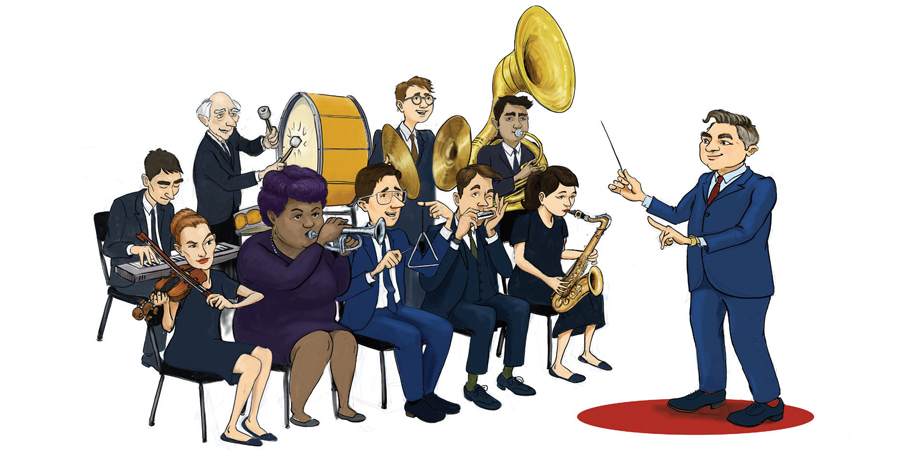Collaborative leadership makes better use of the diverse talents in an organization by focusing them on a common objective

The image of the leader as the hard-charging, order-barking autocrat persists in public perception. That style of leadership may be effective in a military setting or an athletic competition, and it may work in certain business operations.
However, a company that needs the innovation and creativity born of collaboration in order to thrive in the marketplace likely won’t get it from a top-down leader, regardless of his or her knowledge of the industry. In today’s complex business climate, no one is going to know it all anyway.
“There’s more and more to know in the world, and you can only have so much in your head,” says Benjamin Jones, strategy professor at the Kellogg School. “So the share of stuff you know as an individual is declining in any field.”
Given that, it makes sense to bring more heads into the mix, to tap the knowledge and insights and even just the basic curiosity of other individuals in the organization.
Certainly, executive decisions have to be made and some measure of direction from the top is always necessary, but establishing and then leading a collaborative enterprise requires much more than stating an objective and expecting it to be achieved.
It takes work and thought and—no surprise—leadership. That leadership takes multiple forms. Leaders have to know where they want to go—higher profit margins, greater market share, a more sustainable manufacturing process, a more efficient supply chain—but also have to know they can’t get there without the collaborative effort of those they lead. It just won’t happen.
So how does it happen? It happens through a combination of insight and intuition, of experience and understanding, of disparate skills that blend to accomplish a common goal.
It requires building teams, not just for appearances, but also to gain the benefit of varied viewpoints and new perspectives on challenges. A University of Michigan study found that teams of employees with diverse skill sets and backgrounds performed better in solving difficult problems than teams which—on paper—appeared to have better credentials and had greater experience in the problem area.
That may seem surprising at first glance, but consider that the more diverse teams may be more open to new approaches, ask different questions, and don’t create the sort of echo chambers found in teams made up of people from similar backgrounds, educations, and experiences. Effective collaborative leaders will recognize this and, rather than feeling threatened by the diversity of thought, will embrace it as a valuable tool for achieving the organization’s goal.
This is an increasingly common point of view among younger workers. A survey by the leadership consulting firm Virtuali and WorkplaceTrends.com found that about half of millennial workers see leadership not as a way to be the boss, but as a way to empower others.
“I try to put cross-functional shops together for thought creation, so there’s not just one silo thinking method,” says Sean Suggs, president of Toyota Mississippi and a 2010 Harbert EMBA graduate. “Also very important to me is diversity of thought. So I want to make sure there are women present, African-Americans present, old, young, seniority, less seniority. When you have that diversity of thought when creating project teams, projects grow a lot faster and you get breakthrough ideas that you’ve never thought about before.”
There’s a sharp contrast between a genuinely collaborative leader and one who asks for input, but really wants affirmation of a view already held or—even worse—a decision already made. That wastes time and undermines employee morale and confidence in the company’s leadership.
In a sense, albeit a healthy one, collaborative leadership does represent a loss of control, and that may be hard to handle for an executive long accustomed to a more directed approach to leadership.
Ultimately, there may be decisions that only a top-level executive can make, but a collaborative approach will better equip that executive to make those final decisions. As business blogger Diana Bailey notes, effective leaders “understand that no one ever has total control over a situation” and will improve their organizations’ prospects “by seeking to inspire their teams to perform well, rather than controlling with an iron grip.”
This approach leads to a greater degree of investment by employees—in their jobs and specific responsibilities, certainly, but also in the greater good of the enterprise and the shaping of its future. Bailey calls it “strategy as a team sport,” noting that “When an organization’s mission belongs only to management, it can never serve as a motivation for rank-and-file employees.”
A 2017 study of more than 1,000 organizations by the Institute for Corporate Productivity found that successful leadership generally hinged on four critical factors—modeling collaborative action, building strong networks among employees, encouraging collaboration across departments, and structuring work effectively.
Thus, the leader’s role doesn’t end with forming a capable and diverse team for a specific project. If a leader is to establish a truly collaborative workplace, he or she also has to step out of the corner office, and get those executive hands dirty by continuing to engage with employees in the pursuit of solutions to the company’s challenges.
As Steve J. Stowell and Stephanie Mead of the Center for Management and Organizational Effectiveness write, “A collaborative approach isn’t always easy; hearing others out and letting them have their say requires a measure of patience. However, there are some significant benefits that come from collaboration, even when it’s hard or inefficient: People discover new insights, become less dependent on the ‘boss,’ develop and learn, increase their capacity for innovation, and become more committed and passionate about decisions and plans.”
Collaboration will only become more important as the workplace—and the workforce—continue to evolve and the marketplace grows more competitive. A 2018 Deloitte survey found that 51 percent of respondents viewed “C-suite collaboration” as “very important.” An American Express study found that a third of millennials believed the conventional CEO model will be irrelevant within 10 years.
The workplace is changing, as are the markets it serves and will seek to serve in the future. The leader who can’t—or won’t—recognize the changes and the potential of collaborative leadership to address them may not last long atop the organizational chart.

Seek that Single Sentence
The specifics may vary among organizations, but some basic principles will guide any successful effort to move away from conventional top-down executive leadership to more productive collaborative leadership. Among them:
Clarify the common purpose.
Leave no doubt about what needs to be accomplished and about why it is important to the future of the enterprise. Team members have to know what is expected of them if they are to stay on track and focus their energies on the objective.
Knock down the silos.
Information that is not broadly shared among collaborators loses much of its value. Open discussion and exchange among departments and divisions brings more people and more perspectives into the process. Treat information as a tool, not a possession.
“Anything goes” won’t go.
You want to encourage creativity and participation, but not at the expense of losing focus. “One of the biggest mistakes that leaders of new teams make is that they say something like ‘Our rule is that we have no rules,’ says Leigh Thompson, a management professor at Kellogg. A document—consider it a charter—that concisely states the goal and responsibilities is a useful tool. Ideally, keep it to one sentence.
It’s about time.
Collaboration should not be a synonym for endless meetings that lengthen everyone’s workday. Instead, collaboration should be a part of daily workflow, simply a chosen way of doing business. If seen as an extra task, just one more thing to do, it’s sure to fail.
Not the Magic Bullet
Diversity is valuable, but must be managed
Ask a group of high-level managers how to help your group make better decisions and what’s the likely answer?
Diversity.
Diversity, whether that be based on demographics, tenure, task expertise, or other factors, can be of great benefit for teams responsible for complex or creative tasks. Such diversity brings in a variety of different task knowledge, experiences, and perspectives when completing the team’s work. That variety can allow a group to make better decisions through an increased number of available alternatives.
However, diversity also needs to be managed well in order for it to translate to better team outcomes. True collaboration is a big part of that. In fact, poorly managed diversity might result in more conflict between team members and poorer team performance.
Research shows that there are two keys to a leader helping to bring out the best in diversity in a team setting. The first is that the leader helps to foster positive beliefs about the benefits of diversity in the team. Part of that is establishing an environment where members of the group feel psychologically safe to voice their opinions. The second is that the leader encourages integration of, and learning from, team members’ unique viewpoints.
Good leaders facilitate a process where group members focus on understanding where people’s ideas are coming from and understanding them instead of simply advocating for their own position. When this happens the odds that a team (and leader) are successful go way up.
Dr. Jaclyn Koopmann
Dean’s Fellow and Associate Professor of Management
Harbert College of Business

